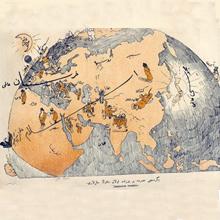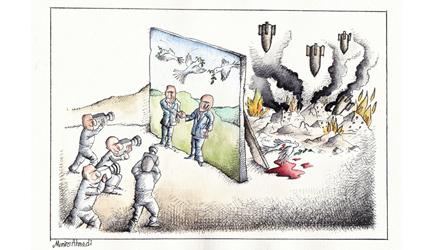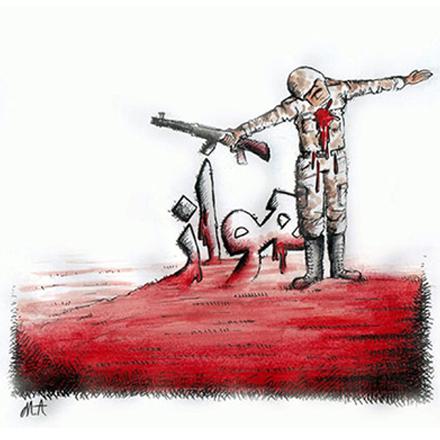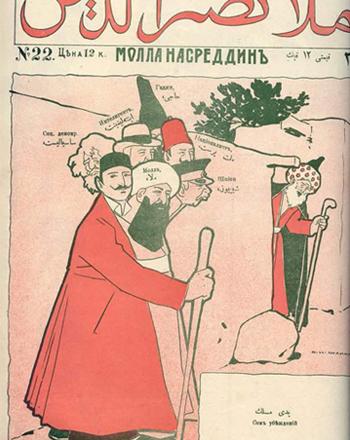
Irán es uno de esos países que llaman nuestra atención, no sólo por su pasado persa, sino también recientemente por el radicalismo de los ayatolás. Así, junto a la “intolerancia musulmana”, el radicalismo del régimen, hay un pueblo que ama el humor, que bate récords de participantes en los Festivales Internacionales de Humor; que cuenta con dos Casas/Museos del Humor (Teherán y Tabriz) y es el país con mayor número de caricaturistas activas en concursos. Muchos de los artistas tuvieron miedo de responder por posibles represalias, y terminaron, después de mucha insistencia, respondiéndome cuatro (entre ellos un artista) pidiéndome que mantuviera el anonimato.
El Irán de hoy es heredero de una larga historia... «Irán es un país con una historia de 2.500 años - nos dice la SS - pero, desgraciadamente, ha sido objeto de numerosas guerras y fue derrotado hace 1.400 años por los árabes y Convertido al Islam Hasta hace 50 años, el gobierno de Irán era imperial y había libertad. Ahora tenemos un gobierno religioso radical, extremadamente corrupto, lleno de restricciones hipócritas, con líneas rojas en relación al Estado y a la religión».
«Sí, es absolutamente cierto – afirma el dibujante MA – que Irán tiene un rico patrimonio y una civilización rica. El arte iraní, independientemente del lugar y la época de su origen, refleja el espíritu y los deseos de los iraníes. Nosotros, los iraníes de diferentes grupos étnicos, e incluso con diferentes idiomas: fars, kord, turco azerí, lor, baluch y árabes, musulmanes o no, vivimos y trabajamos juntos en armonía. Por ejemplo, yo soy de ascendencia kurda y tengo buenos amigos de otras etnias».
«Irán tiene una larga herencia, – refuerza AS – persa, mongol, musulmana, azerbaiyana…. ¿Cómo se manifiesta esto en el humor iraní? Aunque Irán fue atacado por Grecia, árabes, mongoles, afganos, etc. Durante los últimos 2.300 años, los iraníes han preservado su identidad, cultura e idioma. Por supuesto, estas invasiones provocaron diversidad racial. En mi opinión, una de las formas de resistir la invasión extranjera es mantener la moral y, en consecuencia, el sentido del humor. Así que una de las fuentes de los chistes eran estos invasores/enemigos. También puedes ver esto en la poesía clásica iraní. Este método, de reírse de la opresión, también fue utilizado contra los dictadores que gobernaron Irán a lo largo de la historia, fomentando el diseño gráfico tras la Revolución Constitucional (de 1906), cuando comenzó la lucha iraní por la democracia».
¿Existen diferencias entre el norte (Tabriz) y el sur (Teherán)? «Para comparar Tabriz y Teherán en el ámbito de la caricatura - continúa AM - primero debemos mirar la historia del caricaturismo en estas dos grandes ciudades.
Tabriz, como ciudad más grande del noroeste de Irán, ha sido influenciada por la cultura del noroeste (más azerbaiyana) y la democracia europea. En esta zona se fundó en 1906 la revista «Molla Nasraddin», que se publicó primero en Tbilisi (1906-1917) y luego en Tabriz (1921) y Bakú (1922-1931). Publicada durante unos veinte años, la revista generó lectores que se familiarizaron con el mundo de la política a través del humor. Este sería el periódico que influiría en la creación del semanario «Sur Israfil» en Teherán.
Como capital de Irán, es natural que Teherán sea el centro de actividades en la lucha por la democracia. En 1907 se publicó en Teherán un semanario político-satírico llamado “Sur Israfil”, que alcanzó una tirada de 24.000 ejemplares. La parte más interesante del semanario fue una columna humorística llamada "Charand y parand" de Ali Akbar Khan Qazvini (Dehkhoda). Dehkhoda publicó críticas políticas con gran humor, en un estilo de escritura sin precedentes en la literatura persa, creando así una nueva escuela en el mundo del periodismo iraní y la prosa contemporánea. Desafortunadamente, este periódico duró poco ya que su editor fue estrangulado por los agentes de Mohammad Ali Shah.
La Revista «Molla Nasereddin» siguió existiendo, siempre oponiéndose a la injerencia de la religión en los asuntos privados, en la libertad de las personas, siempre luchando por una sociedad laica. Por esta razón, los clérigos iraníes emitieron una fatwa contra la revista “Molla Nasereddin” y contra su fundador.
Quizás sea por esta historia que Teherán y Tabriz ahora son conocidos como dos centros del caricaturismo en Irán. A partir de esa fecha se creó el “Museo de los dibujos animados de Tabriz”, pero la función de los dibujos animados humorísticos en Tabriz hoy es completamente diferente a la de un país. hace cien años. Esto significa que hoy en día no se producen caricaturas críticas con el gobierno, sólo dibujos divertidos y neutrales para exposiciones porque están financiados por el gobierno.
En Teherán, la “Casa Iraní de la Historieta” y la “Bienal de la Historieta de Teherán” tampoco pueden funcionar de forma independiente porque están bajo la supervisión de la Municipalidad de Teherán y el Ministerio de Cultura. Esta es la razón por la que la mayoría de los caricaturistas independientes en Irán perdieron contacto con ambas instituciones después del Movimiento Verde en Irán en 2009».
Irán es una potencia mundial del humor gráfico. Es el país donde hay más mujeres para dibujar. ¿Existen escuelas de humor gráfico? ¿Es una forma de irreverencia, de crecimiento mental?
«El estado de ánimo iraní – nos explica MA – es fuerte, debido a las presiones económicas y sociales, a los problemas de derechos humanos a los que nos enfrentamos cada día. Necesitamos expresarlo a través del humor, dulce o amargo.
Sí, hay muchos caricaturistas en Irán que crean, a pesar de la presión que nos rodea. Por ejemplo, trabajo en condiciones asfixiantes: soy el único dibujante en una ciudad de unos 300.000 habitantes. Los temas que intento abordar son mis inquietudes o las de la sociedad, problemas que muchas veces hay que censurar.
No hay escuelas ni academias gráficas formales en Irán. Tengo una licenciatura en artes gráficas y he enseñado humor gráfico de forma privada e informal. Se han hecho esfuerzos para establecer escuelas y colegios oficiales, pero han fracasado. Este arte es una especie de herramienta para nosotros, hombres y mujeres, y estoy feliz de tener este poder en mis manos».
«Debido a las líneas rojas del gobierno – añade SS – las caricaturas en la prensa en Irán son muy débiles y los jóvenes se inclinan más por las caricaturas temáticas y los concursos internacionales. Contamos con jóvenes inteligentes, que luchan por su futuro, por eso participan intensamente en estos salones. Por un lado, porque aquí un premio en euros o dólares vale mucho, por otro, para crear un currículum para escapar del país, pedir asilo en el extranjero o simplemente para expresar estados de ánimo y entretenimiento. En relación con las mujeres, las asociaciones de dibujos animados son muy populares y activas aquí y las niñas expresan de esta manera sus opiniones y utilizan su fuerza creativa».
«Los iraníes son personas inteligentes – concluye AM - y aprovechan cada oportunidad para expresar sus ideas. En sociedades dictatoriales donde la gente no puede criticar abiertamente al gobierno, utilizar el humor y la ironía es la mejor solución, razón por la cual los iraníes son maestros haciendo bromas. Como en Irán, también ocurre en otras sociedades con los mismos problemas, como América Latina, China, Europa del Este… regiones donde la caricatura mantiene altos niveles de creatividad.
Pero la mala noticia es que en los últimos tres años, debido a la crisis económica en Irán, ninguno de los caricaturistas iraníes puede ganarse la vida trabajando en la prensa. Se cerraron los periódicos independientes y los periódicos restantes eliminaron en gran medida las caricaturas de sus páginas para ahorrar dinero. Por ello, los dibujantes iraníes que aún no han inmigrado se dedican a otros trabajos como la ilustración o la gráfica y en ocasiones participan en concursos.
La presencia de un gran número de caricaturistas en Irán tiene varias razones: en primer lugar, a diferencia de otras sociedades de Oriente Medio, las mujeres iraníes históricamente han luchado por sus derechos, y la caricatura es una forma de afirmarse. En segundo lugar, debido a las restricciones gubernamentales a las mujeres, su presencia en áreas como el canto, la música y algunos deportes es difícil o incluso imposible y la caricatura es una solución de bajo costo para el talento femenino.
Al contrario de lo que pueda parecer, en Irán, a excepción de las clases de dibujo humorístico en la «Casa Iraní de Dibujos Animados» y en la «Asociación de Dibujos Animados» en algunas ciudades, no existe ninguna facultad para enseñar dibujos animados humorísticos. Realmente es el talento personal de los iraníes.
Por último, no podemos ignorar el hecho de que somos buenos haciendo dibujos «neutrales», ganando muchos festivales internacionales, y también que entre 1990 y 2015 tuvimos once artistas interrogados/arrestados».




Humors of the World – Iran
By: Osvaldo Macedo de Sousa
Iran is one of those countries that attract our attention, not only because of its Persian past, but also recently because of the radicalism of the Ayatollahs. Thus, alongside “Muslim intolerance”, the radicalism of the regime, there is a people who love humor, who break records of participants in International Humor Festivals; which has two Humor Houses / Museums (Tehran and Tabriz) and is the country with the largest number of active female cartoonists in competitions. Many of the artists were afraid to respond because of possible reprisals, and ended up, after much insistence, four responding to me (among them an artist) asking me to remain anonymous.
Today's Iran is heir to a long history... «Iran is a country with a history of 2,500 years, - SS tells us - but, unfortunately, it has been the object of many wars and was defeated 1400 years ago by the Arabs and converted to Islam. Until 50 years ago, Iran's government was imperial and there was freedom. Now, we have a radical religious government, extremely corrupt, full of hypocritical restrictions, with red lines in relation to the state and religion».
«Yes, it is absolutely true – says cartoonist MA – that Iran has a rich heritage and civilization. Iranian art, regardless of the place and time of its origin, reflects the spirit and desires of Iranians. We, Iranians from different ethnic groups, and even with different languages – Fars, Kord, Turk Azeri, Lor, Baluch and Arabs, Muslim or not, live and work together in harmony. For example, I am of Kurdish descent and I have good friends from other ethnicities».
«Iran has a long heritage, – reinforces AS – Persian, Mongolian, Muslim, Azerbaijani…. How does this manifest itself in Iranian humor? Although Iran was attacked by Greece, Arabs, Mongols, Afghans, etc. During the last 2300 years, Iranians have preserved their identity, culture and language. Of course, these invasions caused racial diversity. In my opinion, one of the ways to resist foreign invasion is to maintain morale and, consequently, maintain a sense of humor. So one of the sources of the jokes were these invaders/enemies. You can also see this in classical Iranian poetry. This method, of laughing at oppression, was also used against the dictators who ruled Iran throughout history, encouraging graphic design after the Constitutional Revolution (of 1906), when the Iranian struggle for democracy began».
Are there differences between the north (Tabriz) and the south (Tehran)? «To compare Tabriz and Tehran in the field of caricature, - continues AM - we must first look at the history of cartoonism in these two large cities.
Tabriz, as the largest city in northwestern Iran, has been influenced by northwestern (more Azerbaijani) culture and European democracy. In this area, the magazine «Molla Nasraddin» was founded in 1906, published first in Tbilisi (1906-1917) and then continuing in Tabriz (1921) and Baku (1922-1931). Published for around twenty years, the magazine created readers who became familiar with the world of politics through humor. This would be the newspaper that would influence the creation of the weekly «Sur Israfil» in Tehran.
As the capital of Iran, it is natural that Tehran would be the center of activities in the struggle for democracy. In 1907, a political-satirical weekly called “Sur Israfil” was published in Tehran, reaching a circulation of 24,000 copies. The most interesting part of the weekly was a humorous column called "Charand and parand" by Ali Akbar Khan Qazvini (Dehkhoda). Dehkhoda published political criticism with great humor, in a writing style unprecedented in Persian literature, thus creating a new school in the world of Iranian journalism and contemporary prose. Unfortunately, this newspaper was short-lived as its editor was strangled by Mohammad Ali Shah's agents.
The Magazine «Molla Nasereddin» continued to exist, always opposing the interference of religion in private matters, in the freedom of individuals, always fighting for a secular society. For this reason, Iranian clerics issued a fatwa against the magazine “Molla Nasereddin” and against its founder.
Perhaps it is because of this story that Tehran and Tabriz are now known as two hubs of cartoonism in Iran. The “Tabriz Cartoon Museum” was created from that date onwards, but the function of humorous cartoons in Tabriz today is completely different. from a hundred years ago. This means that, today, caricatures critical of the government are not produced, only fun, neutral drawings for exhibitions because they are funded by the government.
Contrary to what it may seem, in Iran, except for humor drawing classes at the «Iranian Cartoon House» and the «Cartoon Association» in some cities, there is no faculty for teaching humorous cartoons. It really is the personal talent of the Iranians.
Finally, we cannot ignore the fact that we are good at «neutral» drawings, winning many international Festivals, and also that between 1990 and 2015 we had eleven artists interrogated / arrested».
In Tehran, the “Iranian Cartoon House” and the “Tehran Cartoon Biennial” also cannot operate independently because they are under the supervision of the Tehran Municipality and the Ministry of Culture. This is why most independent cartoonists in Iran lost contact with both institutions after the Green Movement in Iran in 2009».
Iran is a global powerhouse of graphic humor. It's the country where there are more women to draw. Are there graphic humor schools? Is it a form of irreverence, of mental growth?
«The Iranian mood – MA explains to us – is strong, because of the economic and social pressures, the human rights problems that we face every day. We need to express it through humor, sweet or bitter.
Yes, there are many cartoonists in Iran who create, despite the pressure that surrounds us. For example, I work in stifling conditions: I'm the only cartoonist in a city of around 300,000 inhabitants. The subjects I try to address are my concerns or those of society, problems that often have to be censored.
There are no formal graphic schools or academies in Iran. I have a degree in graphic arts, and I have taught graphic humor privately and informally. Efforts have been made to establish official schools and colleges, but have failed. This art is a kind of tool for us, men and women, and I'm happy to have this power in my hands».
«Due to the government's red lines, – adds SS – press cartoons in Iran are very weak and young people are more inclined towards themed cartoons and international competitions. We have intelligent youth, who fight for their future, which is why they participate intensely in these salons. On the one hand, because a prize in euros or dollars is worth a lot here, on the other hand, to create a CV to escape the country, seek asylum abroad or for simple expression of moods and entertainment. In relation to women, cartooning associations are very popular and active here and girls express their opinions in this way and use their creative strength».
«Iranians are intelligent people – concludes AM - and use every opportunity to express their ideas. In dictatorial societies where people cannot openly criticize the government, using humor and irony is the best solution, which is why Iranians are masters at making jokes. As in Iran, it also happens in other societies with the same problems, such as Latin America, China, Eastern Europe... regions where caricature maintains high levels of creativity.
But the bad news is that in the last three years, due to the economic crisis in Iran, none of the Iranian cartoonists can make a living working in the press. Independent newspapers were closed and the remaining newspapers largely removed cartoons from their pages to save money. Therefore, Iranian cartoonists who have not yet immigrated dedicate themselves to other work such as illustration or graphics and sometimes participate in competitions.
The presence of a large number of female cartoonists in Iran has several reasons: first, unlike other Middle Eastern societies, Iranian women have historically fought for their rights, and caricature is a way of asserting themselves. Secondly, because of government restrictions on women, their presence in areas such as singing, music and some sports is difficult or even impossible and caricature is a low-cost solution for female talent.
